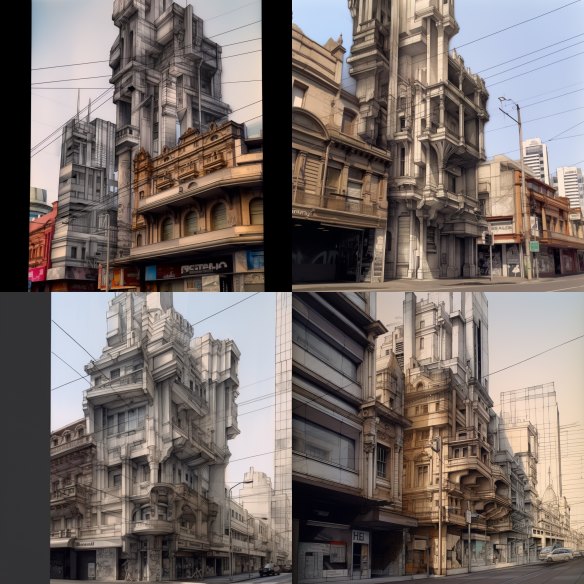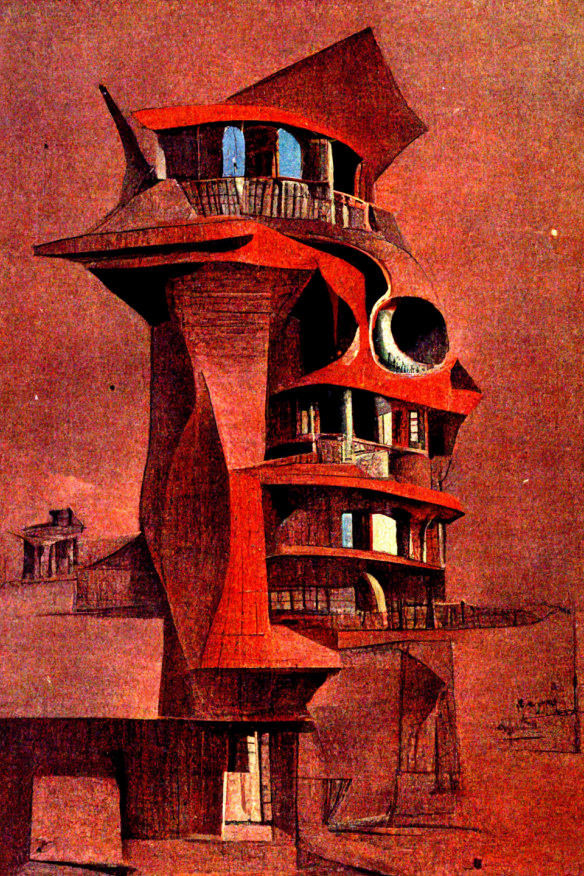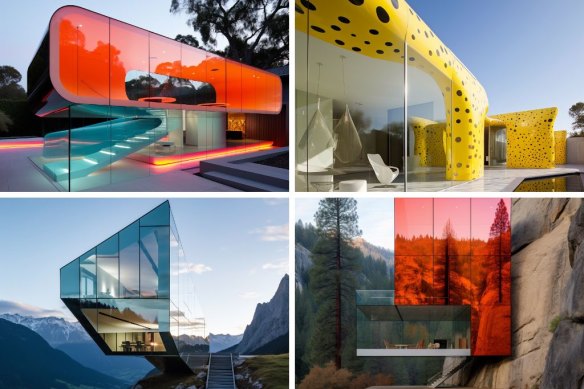What do you get when you cross a Porsche with a chair? Or a Max Ernst painting with a building? If these sound like questions begging a punchline, it is no joke. Some call these Dada-esque outcomes “machine hallucinations”; optimists call it the future of design. Pessimists predict the death of the architect.
Such left-field prompts from RMIT students are being thrown at artificial intelligence (AI) programs such as Midjourney. They free up the design process, push the conceptual envelope and generate beguiling images. They also circumvent creative block. “[AI] completely eliminates that friction to generating ideas,” says RMIT lecturer Gwyllim Jahn, who has been testing the new programs from inception.

AI-generated sofa designs: a Porsche 911 turbo (main); a Lamborghini Diablo; the the McDonald’s logo. Credit: Courtesy RMIT
You don’t need to be a designer to produce impressive concepts. Instagram and Discord are awash with the bastard offspring of Frank Lloyd Wright’s Fallingwater and Zaha Hadid Architects’ Heydar Aliyev Center. Want greater green credentials? One prompt and your building is grafted with shrubs or reimagined as a treehouse, an environmental oasis in whatever literal or cultural desert it’s placed. If only real life were so easy.

Works in progress: based on a prompt, Midjourney provides four options that can be finessed until the desired result is achieved.Credit: Courtesy RMIT
From an initial prompt, Midjourney produces four images that a human (in this case a designer) selects and refines with additional prompts. In just a few hours two dozen or so iterations will emerge, with startling results. While AI has been in the air since the 1950s, in the past 18 months software capabilities have accelerated from relatively unimpressive two-dimensional images to hyperrealistic 3D renders. (Similar text-to-image programs include DALL-E, Stable Diffusion and DreamStudio.)
“The 2020s are all about AI,” write Neil Leach and Matias del Campo in their book Machine Hallucinations (2022). “[It is] the first genuinely 21st century design technique that is revolutionising architectural culture.”
Architecture firms at the forefront of digital design such as ZHD (Zaha Hadid Design) and Coop Himmelb(l)au are dedicating staff to exploring the disruptive technology. Deep Himmelblau is the German studio’s multistage process of familiarising AI with the firm’s design vocabulary. Its AI will then generate and finetune new ideas.
Coop Himmelb(l)au co-founder Wolf Prix refers to AI as “co-workers” expert in various aspects of the building process, variously producing plans, checking building regulations or crunching budgets.
In interviews Prix impishly imagines his ideal future, in which AI churns through everything from design to robotic construction while he and his staff languish “on a beach in the Maldives”, returning only briefly to submit their invoice. This is pure fantasy, of course. Invoices could be sent from the island. More likely, AI will do that as well.

A prize-winning architectural rendering in the style of Max Ernst by Gwyllim Jahn.
But just how long clients indulge such a hedonistic business model before demanding a radically reduced bill also needs to be considered. Time constraints, too, will be crunched further by savvy clients all too aware of the capabilities of these high-achieving AI co-workers. Leach, who also wrote Architecture in the Age of Artificial Intelligence (2021), goes further, wondering if “once AI is able to design buildings for us, will this not lead to ‘The Death of the Architect’?”
Dan Hill, director of the Melbourne School of Design at the University of Melbourne, is neither defeatist nor Dionysian. “If we thought of AI as applied statistics the whole thing gets a lot less sexy, but it gets closer to the reality of it,” he says. “It’s crunching vast amounts of statistical data – pattern matching on an extraordinary scale.”
This is particularly useful for designing at the city scale. “[It] will absolutely transform the practices of urban planning to figure out where space could be used more effectively,” Hill says.
Some of this data is already incorporated into design decisions. Hill predicts local councils will all have data science teams. By scrutinising transport movements, AI could help remove 50 per cent of cars from our roads. And architects? “I don’t think it puts architects out of business at all. But it definitely changes the dynamic for the better.”
Just as streets can be reimagined, workplace design can be transformed based on employee traffic flows. “We might use AI inside buildings for office layouts and employee patterns, directing people to the most interesting, safest, or convivial space. How do we optimise the workspace so that it balances across people working from home, who’s working in the office with who? All of that stuff that’s really hard to do.” The average office buildings are notoriously wasteful, he says, “with a huge amount of redundancy built into it in terms of desk space.” AI could also grapple with retrofitting underused office buildings into apartments.

Colourful box in the Alps: AI architecture by Neil Leach. Instagram @neilleach14
“Designing a residential apartment block, factoring in site orientation, ensuring it’s carbon positive, catering for an intergenerational family environment, what materials, floor-plan layouts – AI can do that stuff in its sleep,” says Hill. “Where do we put the laundry, how much water does it need, how are the solar cells on the roof going? AI will not only help with plans and material choices, but free architects to do the stuff architects are good at, and that computers aren’t.
Loading
“It means the architect can spend more time on the question-asking end of the thing, getting the brief right, running a participative design process like holding community meetings. That takes a lot of human skills that architects and other designers are trained for: following up afterwards, adapting the building over time. Hardly any of those things currently happen because of a very cumbersome design process.”
Every sceptical caveat regarding AI – from the current lack of 360-degree renders to the eventual upheaval of the design profession – is met with a seer’s certainty: “just wait”.
Single streamlined platforms will soon process everything from data to design and fabrication, factoring in every aspect of performance from acoustics to environmental credentials, and automatically accord with planning and building codes. It will adhere to budgets while offering previews in augmented reality and VR.
“That is going to be the big change and is already happening,” says Leach, via Zoom from California. “Chinese company XKool [LookX in the West] is currently developing AI software to be released in around three years’ time.”
Leach likens such a design platform to self-driving cars. “We don’t know exactly when self-driving cars are going to really work, but we know eventually they will. And that is really more serious than just doing these little [Midjourney] sketch images. [AI] is improving according to Moore’s law – basically things get exponentially faster. It is both amazing and terrifying.”

AI-generated architecture by Niel Leach: Orange Blob; Yayoi Kusama Yellow; Red Box Yosemite; Koolhaas Alps 3. Instagram @neilleach14Credit: Neil Leach
Leach is more pessimistic about the architect’s future. Next year he will publish The Death of the Architect: the Demise of the Profession in the Age of AI. “It looks at how AI is going to eclipse us,” he says.
Brand name architects will probably survive, because commissioning starchitects “will be like showing who can afford a Prada bag”. But lesser-known designers will have to compete in a potential “race to the bottom”.
Will the average home owner bother engaging an architect at all? “Anyone [will be able to] design [a project] for themselves,” says Leach. “Increasingly they’re going to be bypassing architects and going straight to a builder and say, ‘listen, I’ve done this. What do you think? Can you build it for me?’” And perhaps the builder’s team of robots will construct it too.
In making it infinitely easier to apply sampling culture to architecture, AI might create the apotheosis of postmodernity, not to mention reignite discussions about the death of the author. But such aesthetic and occupational hazards pale into insignificance against the bigger existential crisis – that humans themselves may be made redundant.
Loading
“Technology is the answer, but what was the question?” British architect Cedric Price famously asked. In Scary Smart (2021) ex-Google X executive Mo Gawdat cautions that we must take time out to determine what values and ethics we want to instil in AI to avoid any dangerous biases. Gawdat likens it to parents of a child with super powers. It’s up to us whether AI becomes hero or villain.
“City governments need to get up to speed very rapidly indeed, because we don’t have policymakers that are at the cutting edge of thinking about this at the moment, and they need to be,” says Dan Hill. He’s referring to design, but it lies at the heart of all AI discussions. Without ethics, these machine hallucinations could turn into a bad trip.
The Booklist is a weekly newsletter for book lovers from books editor Jason Steger. Get it delivered every Friday.





